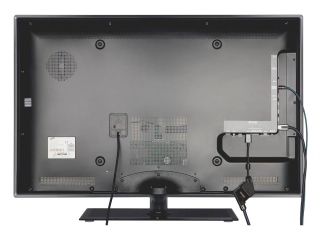
Swiveling my flat screen television around and exposing the back side shows the physical limitations that currently define the new television networks. There used to be three major networks dominating the thirteen available VHF over-the-air transmission channels. The other channels were filled with snow and white noise. When the primary distribution method migrated from broadcast signal to coaxial cable, the boundaries defining a television network began to change.
When we turn the television wrong way round, we see the huge variety of potential connectors. A closer look reveals that many of them are vestigial appendages awaiting nostalgic connections from outmoded devices. It’s the HDMI connections that define the number high-definition inputs that can flow onto the big screen. Some sets have only two, but three, four and even 5 HDMI inputs are becoming much more common as the number of Networks competing for slots continues to grow. If the model of ‘three screens and a cloud’ still holds, television is evolving into the big screen, and the HDMI connector is the new channel selector.

The slots in my rig are claimed by Comcast’s high-definition cable and DVR device, a local DVD Player and an Apple TV2. The nostalgic connectors are taken by a rarely used VCR and a cable that takes input when attached to a Flip cam. I can easily imagine other households where a gaming console would claim a slot. Apple has taken a slot that might have been occupied by Google, Roku, Hulu or Microsoft. These are the players forming the new big screen networks. One would expect a fair amount of M&A activity in this area as the networks stabilize their positions.

Tracing the trajectory of these lines, one can speculate on the evolution of the big screen device. The growth of HDMI will start to crowd out the nostalgic connectors. Channel switching, at the HDMI network level, will turn into a primary capability of remote controls. Navigation within the networks will become customized and a point of competition. The concept of associating big screen programming with a numbered channel will begin to fade away.

Live and recorded programming will make up the two top level categories. Recorded programming will be findable through search and preference algorithms. Live programming will become visible through tracking a social message stream (listening for events) and appointment calendars. Some of the HDMI connected devices will start to migrate into the body of the big screens, these will be the dominant new networks.
We take the On/Off power switch on the big screen for granted. Turn the television off! I’ve turned into a couch potato, turn the damn thing off! At the other end of the spectrum—If you’re good, we’ll turn the television on for a few hours tonight. The power switch can turn the television into an inert piece of furniture. Soon the power switch won’t be a part of the remote control. Just as with desktop, tablet and mobile computing devices, the big screen will be always on—it will either be in an active, screensaver or sleep mode.

A key battle among the new networks will center on owning the period of time that the television used to be powered off. Screensavers will evolve to show weather, stock market data, sports scores, news photography and many other kinds of ambient information streams. The dormant big screen will always be ready and waiting for streams pushed to it from mobile and tablet devices via AirPlay. One can also easily imagine transferring personal video calls to the big screen for group participation. Push messages will also make their way to the big screen, perhaps to remind you that your favorite show is on in ten minutes or that the baseball team you root for just won their game with a two-out, two-strike hit in the ninth inning.
In the story of three, or now four screens, and a cloud, we tend to focus on the screens. After all it’s the screens that provide us with something to look at. But as these new networks begin to form, it may be instructive to turn the cloud the wrong way round and look at the wiring coming out of the back.

The cloud looks like a large factory. If we followed the wiring diagram from the big screen, out through the HDMI connector to the AppleTV device, over the WIFI (802.11n) signal to the home router, through the wires of the internet, in most cases we’d end up at one of these industrial cloud complexes. This is what the other end of the real-time network looks like.
Jon Stokes, writing for Ars Technica, in his analysis of Facebook’s move to open source their datacenters, makes an interesting observation:
The idea that Google and Facebook are somehow competing with one another in the datacenter space may sound odd at first, given that most people are used to thinking of Google somewhat vaguely as an ad-supported software company. But as we’re fond of pointing out, Google is essentially a maker of very capital-intensive, full-custom, warehouse-scale computers—a “hardware company,” if you will. It monetizes those datacenters by keeping as many users as possible connected to them, and by serving ads to those users. To make this strategy work, it has to hire lots of software people, who can write the Internet-scale apps (search, mainly) that keep users connected and viewing ads. Since the price of Google ads is set largely independently of Google’s cost of delivery, every dollar of efficiency that Google can wring out of one of these large computers is a dollar that goes to the bottom line. Facebook now finds itself in a similar business.
While Stokes’s topic is competition at the level of datacenters, he exposes the fundamentals of the network business model. Cloud factories are monetized by keeping as many users as possible connected to them and serving ads to those users. Each user click on an ad causes a dollar to flow through the system. A click that rents a recorded television show does the same thing.

The cloud exists to deliver popular internet-scale programming—it’s the distribution business. Just a lot of big factories nestled into the landscape, nothing much to see, it’s content that’s king. Keep your eyes on the screen. But as Stokes points out, it’s the job of “content” to keep the number of users connected to the datacenter growing so that clicks can be turned into dollars.

Once the industrial cloud complex is running at optimal capacity, the balance of power shifts. What was once a couple of kids putting on a show in the barn, or four mop tops singing love songs for teenagers, becomes big business. Really big business. It’s also the moment when the Internet business turns into show business. The dream factory is reborn. And the film and pop stars are still working for the studio—haven’t we seen this movie before?









